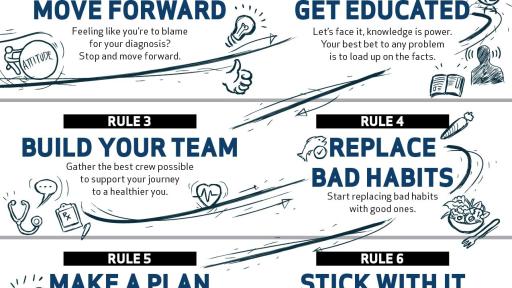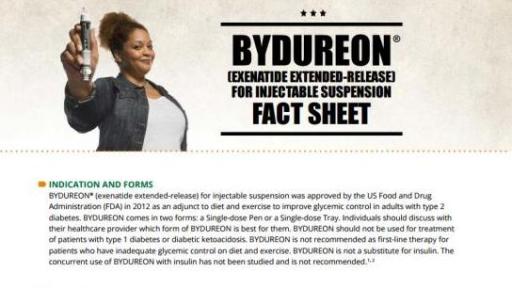ASTRAZENECA PARTNERS WITH DR. PHIL TO LAUNCH THE “ON IT” MOVEMENT FOR PEOPLE WITH TYPE 2 DIABETES
Talk show host and former practicing clinical psychologist shares his own experience of living with type 2 diabetes and working with people to take action over their disease
.@DrPhil joins @AstraZeneca to launch the #ONITMovement for Type 2 #diabetes. OnItMovement.com Tweet
PR Newswire – (WILMINGTON, Del., March 10, 2016)
When Dr. Phil McGraw was diagnosed with type 2 diabetes 25 years ago, he made a commitment to get on – and stay on – a healthy path. Now, AstraZeneca is partnering with the host of the top-rated Dr. Phil show. He will share his personal experience with type 2 diabetes with the millions of people living with the disease as part of the ‘ON IT’ Movement, an awareness campaign that seeks to empower adults living with type 2 diabetes to make a personal commitment to living a healthier life.
“I’m excited to team up with AstraZeneca on the ON IT Movement to help inspire people to tackle the psychological barriers to managing type 2 diabetes,” Dr. Phil said. “In my past professional experience, I saw many people struggle to take the first step toward living a healthier life. The ON IT Movement is about providing people with type 2 diabetes insight into the challenges they may face and the tools to successfully overcome those challenges and better manage their health.”
At the core of the ON IT Movement is Dr. Phil’s “6 Rules to Get ON IT.” At OnItMovement.com, Dr. Phil explains these six rules in a series of motivational videos:
- Move forward. Tackle your type 2 diabetes head on – no more guilt, no more being overwhelmed.
- Get educated. Understand more about type 2 diabetes so you’ll be armed with the know-how to fight back more effectively.
- Build a team. Pull together a team – your doctor, your spouse, your kids, a trainer at a gym or your buddies at work – and lead it.
- Replace bad habits. Think about which aspects of your lifestyle need to change, and one by one, replace the bad habits with good habits.
- Make a plan. Have goals and create a plan to get you to those goals.
- Stick to it. Join the ON IT Movement to learn more about tools that can help you stick to your plan – whether it’s finding healthy recipes, getting ideas for exercising or learning how to change your everyday habits.
“Type 2 diabetes can cause under-appreciated psychological challenges for patients in addition to its better-recognized physical impact,” said Dr. Pamela Kushner, MD, FAAFP, clinical professor of family medicine at the University of California, Irvine Medical Center. “In my decades of experience treating patients with type 2 diabetes, I have seen how overcoming these daily challenges can help patients reach their treatment goals and live healthier lives.”1
The ON IT Movement complements AstraZeneca’s existing educational resources and support programs that help people with type 2 diabetes live a healthy lifestyle. AstraZeneca offers SteadySTART™, a diabetes education program that focuses on helping adults with type 2 diabetes by offering them access to Clinical Educators, who provide education focused on healthy eating and being active, as well as treatment support for patients who have been prescribed BYDUREON® (exenatide extended-release) for injectable suspension, a once-weekly non-insulin injectable medication. In addition, AstraZeneca’s Fit2Me™ resource is a free diet and lifestyle support program that allows people with type 2 diabetes to create a customized plan that is personalized based on their likes and dislikes.
“AstraZeneca is committed to patient health and education, and we believe that lifestyle and behavior modifications, along with medications, are an important component to treating chronic diseases,” said Topher Brooke, vice president, Diabetes, AstraZeneca. “The ON IT Movement is just one example of how we empower patients with resources and education. By partnering with Dr. Phil, we can offer people with type 2 diabetes unique tools and information to get ON IT – and stay ON IT – when it comes to their disease management plan.”
Dr. Phil has been on multiple different treatments since being diagnosed with the disease. Working with his treatment team, and in combination with a healthy diet and exercise, he has been successfully managing his type 2 diabetes since 2012 with a treatment plan that includes BYDUREON.2
For more information and to join the movement, please visit OnItMovement.com.
APPROVED USES for BYDUREON® (exenatide extended-release) for injectable suspension
BYDUREON is an injectable prescription medicine that may improve blood sugar (glucose) in adults with type 2 diabetes mellitus, and should be used along with diet and exercise.
BYDUREON is not recommended as the first choice of medicine for treating diabetes.
BYDUREON is not a substitute for insulin and is not for people with type 1 diabetes or people with diabetic ketoacidosis.
BYDUREON is a long-acting form of the medication in BYETTA® (exenatide) injection so both drugs should not be used at the same time.
It is not known if BYDUREON can be used in people with a history of pancreatitis or if BYDUREON is safe and effective for use in children.
IMPORTANT SAFETY INFORMATION for BYDUREON
- POSSIBLE THYROID TUMORS, INCLUDING CANCER: Tell your healthcare provider if you get a lump or swelling in your neck, hoarseness, trouble swallowing, or shortness of breath. These may be symptoms of thyroid cancer. In animal studies, BYDUREON and medicines that work like it caused thyroid tumors, including thyroid cancer. It is not known if BYDUREON will cause thyroid tumors or a type of thyroid cancer called medullary thyroid carcinoma (MTC) in people.
- Do not use BYDUREON if you or any of your family members have ever had MTC or if you have an endocrine system condition called Multiple Endocrine Neoplasia syndrome type 2 (MEN 2).
- Do not use BYDUREON if you have had an allergic reaction to exenatide or any of the other ingredients in BYDUREON.
BYDUREON may cause serious side effects, including:
- Inflammation of the pancreas (pancreatitis). Stop using BYDUREON and call your healthcare provider right away if you have severe pain in your stomach area (abdomen) that will not go away, with or without vomiting. You may feel the pain from your abdomen to your back
- Low blood sugar (hypoglycemia). Your risk for getting low blood sugar may be higher if you use BYDUREON with another medicine that can cause low blood sugar, such as a sulfonylurea or insulin. Signs and symptoms of low blood sugar may include dizziness or light-headedness, sweating, confusion or drowsiness, headache, blurred vision, slurred speech, shakiness, fast heartbeat, anxiety, irritability, mood changes, hunger, weakness, or feeling jittery
- Kidney problems (kidney failure). Tell your healthcare provider if you have or had kidney problems. In people who have kidney problems, diarrhea, nausea, and vomiting may cause a loss of fluids (dehydration) which may cause kidney problems to get worse
- Stomach problems. Tell your healthcare provider if you have severe problems with your stomach, such as delayed emptying of your stomach (gastroparesis) or problems digesting food. Other medicines like BYDUREON may cause severe stomach problems. It is not known if BYDUREON causes or worsens stomach problems
- Serious allergic reactions. Stop using BYDUREON and get medical help right away if you have any symptoms of a serious allergic reaction, including itching, rash, or difficulty breathing
- Injection-site reactions. Serious injection-site reactions, with or without bumps (nodules), have happened in some people who use BYDUREON. Some of these injection-site reactions have required surgery. Call your healthcare provider if you have any symptoms of injection-site reactions, including severe pain, swelling, blisters, an open wound, or a dark scab
The most common side effects with BYDUREON may include nausea, diarrhea, headache, vomiting, constipation, itching at the injection site, a small bump (nodule) at the injection site, and indigestion. Nausea is most common when you first start using BYDUREON, but decreases over time in most people as their body gets used to the medicine.
Tell your healthcare provider about all the medicines you take, including prescription and over-the-counter medicines, vitamins, and herbal supplements, as taking them with BYDUREON may affect how each medicine works.
Before using BYDUREON, talk to your healthcare provider about low blood sugar and how to manage it. Tell your healthcare provider if you are taking other diabetes medicines, including insulin or sulfonylureas.
Tell your healthcare provider if you are pregnant or plan to become pregnant. It is not known if BYDUREON will harm your unborn baby. Talk to your healthcare provider first if you are breastfeeding or plan to breastfeed.
Please click here for Medication Guide, and click here for Full Prescribing Information for BYDUREON 2 mg, including Boxed WARNING about possible thyroid tumors including thyroid cancer.
You are encouraged to report negative side effects of prescription drugs to the FDA. Visit www.fda.gov/medwatch or call 1-800-FDA-1088.
About AstraZeneca in Diabetes
AstraZeneca is pushing the boundaries of science with the goal of developing life-changing medicines that aim to reduce the global burden and complications of diabetes. Our commitment to diabetes is exemplified by the depth and breadth of our global clinical research program. AstraZeneca is committed to advancing understanding of the treatment effects of our diabetes medicines in broad patient populations, as well as exploring combination treatment approaches to help more patients achieve treatment success earlier in their disease progression. Our ambition is to reduce the long-term impact of diabetes. As a core strategic area for the company, we are focusing our research and development efforts in diverse populations and patients with significant co-morbidities, such as cardiovascular disease, heart failure, obesity, non-alcoholic steatohepatitis (NASH), and chronic kidney disease.
About Type 2 Diabetes
Diabetes is estimated to affect 29.1 million people in the U.S.3 and more than 415 million people worldwide.4 The prevalence of diabetes is projected to reach more than 642 million people worldwide by 2040.4 Type 2 diabetes accounts for approximately 90-95 percent of all cases of diagnosed diabetes in the U.S.3 Type 2 diabetes is a chronic disease characterized by pathophysiologic defects leading to elevated glucose levels.4,5 Significant unmet needs still exist, as many patients remain inadequately controlled on their current glucose-lowering regimen.6 It is estimated that more than half of people living with type 2 diabetes are not achieving recommended HbA1c goals based on guidelines established by professional societies and advocacy organizations for diabetes management.7
About AstraZeneca
AstraZeneca is a global, innovation-driven biopharmaceutical business that focuses on the discovery, development and commercialization of prescription medicines, primarily for the treatment of diseases in three main therapy areas – respiratory, inflammation, autoimmune disease (RIA), cardiovascular and metabolic disease (CVMD) and oncology – as well as in infection and neuroscience. AstraZeneca operates in over 100 countries and its innovative medicines are used by millions of patients worldwide. For more information please visit: www.astrazeneca-us.com.
CONTACTS
Media Inquiries
Abby Bozarth + 1 302 885 2677 (US)
Molly Wilson + 1 215 542 3379 (US)
1 Gebel, E. Diabetes Distress. Diabetes Forecast. June 2013. http://www.diabetesforecast.org/2013/jun/worried-you-may-have-diabetes-distress.html?loc=dorg. Accessed December 29, 2015.
2 BYDUREON® (exenatide extended-release) for injectable suspension [package insert]. Wilmington, DE: AstraZeneca Pharmaceuticals LP; March 2015.
3 Centers for Disease Control and Prevention. National Diabetes Statistics Report: Estimates of Diabetes and Its Burden in the United States, 2014. Atlanta, GA: U.S. Department of Health and Human Services; 2014.
4 International Diabetes Federation. IDF Diabetes Atlas, 7th ed. Brussels, Belgium: International Diabetes Federation; 2015. http://www.idf.org/diabetesatlas. Accessed January 26, 2016.
5 Kahn SE. The relative contributions of insulin resistance and beta-cell dysfunction to the pathophysiology of type 2 diabetes. Diabetologia. 2003;46:3-19.
6 Cheung B, Lond E, Ong KL, et al. Diabetes prevalence and therapeutic target achievement in the United States, 1999-2006. Am J Med. 2009;122:443-453.
7 Cook M.N., et al. Initial monotherapy with either metformin or sulphonylureas often fails to achieve or maintain current glycaemic goals in patients with type 2 diabetes in UK primary care. Diabetic Med 2007: 24; 350-358.
3210300 Last Updated 3/16





